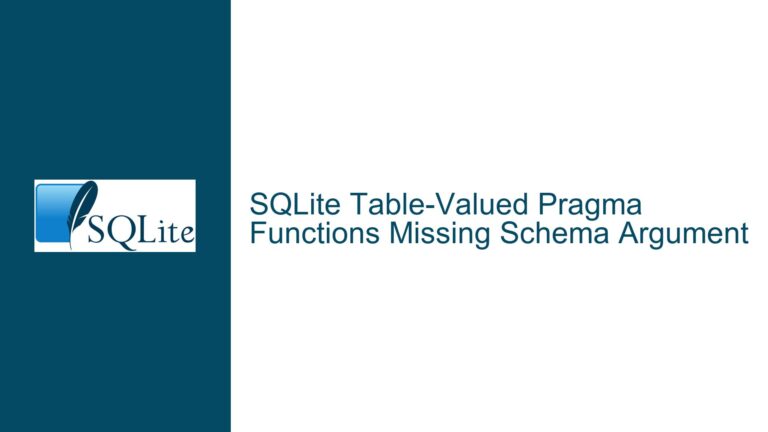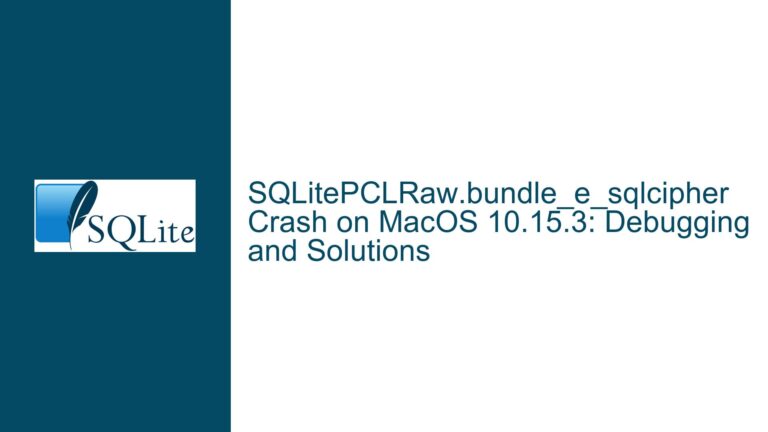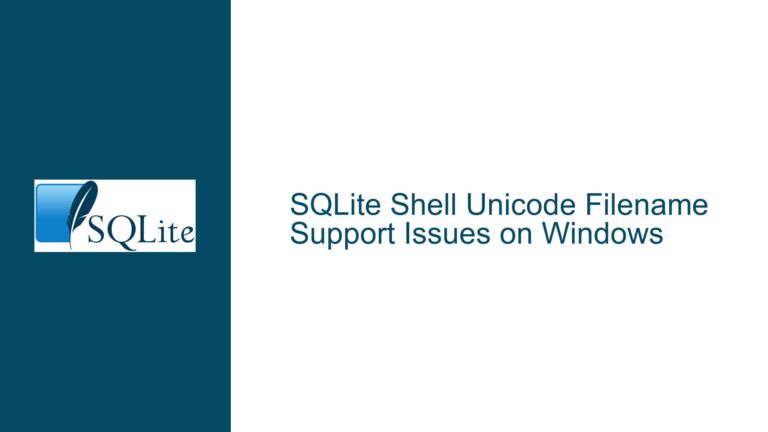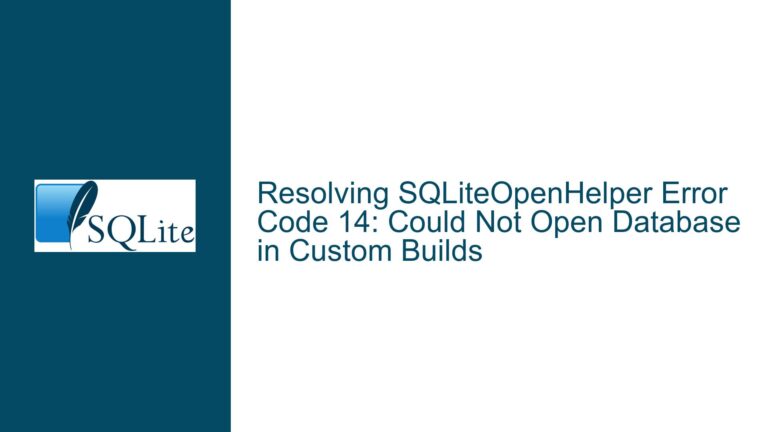SQLITE_SAFER_WALINDEX_RECOVERY and WAL Index Corruption Crashes
WAL Index Recovery Process and Undefined Behavior in Concurrent Scenarios
The core issue revolves around SQLite’s Write-Ahead Logging (WAL) mechanism and how it handles recovery when the shared-memory wal-index (*-shm file) becomes corrupted due to abrupt failures during write operations. The crash described in the forum thread occurs during walIndexRecover()—a function responsible for reconstructing the wal-index after detecting inconsistencies. The stack trace points to memcpy usage in wal.c as the source of undefined behavior (UB), specifically when concurrent read transactions access partially recovered shared-memory regions.
SQLite’s WAL mode maintains two copies of the wal-index header in the *-shm file to ensure atomic updates. During normal operation, a writer updates the second copy first, then the first, and readers check both for consistency. If a writer crashes between updating these headers, subsequent readers detect the mismatch and trigger recovery. The recovery process rebuilds the wal-index by merging valid data from both headers and the WAL file.
The problematic memcpy occurs during this recovery phase. The walIndexRecover() function copies data from a private in-memory buffer (aPrivate[]) to the shared-memory region (aShare[]). If a concurrent reader accesses aShare[] while memcpy is modifying it, the reader might encounter transiently inconsistent data. While SQLite assumes memcpy is atomic for aligned, word-sized operations, this is not guaranteed by the C standard. Certain memcpy implementations (e.g., those using non-temporal instructions or aggressive vectorization) might write bytes in non-atomic ways, leading to torn reads.
The SQLITE_SAFER_WALINDEX_RECOVERY compile-time option replaces memcpy with a byte-by-byte copy loop, ensuring atomicity at the cost of performance. The forum thread questions why this safer method isn’t the default, given the observed crash.
Root Causes: Disk Full Conditions, Concurrency, and Memory Model Assumptions
The crash described in the forum thread is reproducible under a specific sequence of events:
- Disk Full During Transaction: A writer fills the disk mid-transaction, causing an incomplete write to the WAL or
*-shmfile. - Forced Application Termination: The application crashes due to the disk full error, leaving the WAL and
*-shmfiles in an inconsistent state. - Subsequent Recovery Attempt: On restart, the application detects mismatched wal-index headers and initiates recovery.
- Concurrent Access During Recovery: A reader thread/process accesses the shared-memory region while
memcpyis updating it, leading to undefined behavior.
Three critical factors contribute to this issue:
1. Non-Atomic memcpy in Shared-Memory Context
SQLite assumes that copying small, aligned chunks of memory (e.g., the 32-byte wal-index header) using memcpy is atomic. However, the C standard does not guarantee this. On x86_64, memcpy implementations optimized for speed (e.g., AVX-unaligned copies) may use wide vector registers that write memory in non-atomic chunks. If a reader inspects aShare[] during such a copy, it might observe partially updated data, leading to incorrect hash calculations or pointer dereferences.
2. Edge Case in WAL Index Recovery
The scenario where a writer crashes between updating the two wal-index headers is rare. Most failures occur before or after both headers are written. However, disk full errors are exceptions: a writer might successfully write the first header but fail to write the second, leaving the *-shm file in a state where recovery is necessary.
3. Concurrency During Recovery
Recovery is typically a single-threaded process. However, if multiple threads or processes attempt to open the database concurrently, one may initiate recovery while others are already reading. SQLite’s locking mechanisms (e.g., SHARED_LOCK) do not fully serialize access to the shared-memory region during recovery, creating a window for race conditions.
Mitigation Strategies: Compile-Time Options, Application Hardening, and Recovery Protocols
1. Enabling SQLITE_SAFER_WALINDEX_RECOVERY
Recompile SQLite with -DSQLITE_SAFER_WALINDEX_RECOVERY to replace memcpy with a byte-wise copy loop in walIndexRecover(). This ensures atomic updates to aShare[] but incurs a minor performance penalty during recovery.
Implementation Details:
- The safer copy loop uses
volatilepointers to prevent compiler optimizations that might reintroduce non-atomic writes. - This approach is unnecessary for most deployments but critical for applications prone to disk-full errors or running on platforms with non-atomic
memcpy.
2. Handling Disk Full Errors Gracefully
Modify the application to monitor disk space proactively and abort transactions before the disk fills. Use sqlite3_disk_full() (a custom VFS extension) or OS-specific APIs to check available space.
Example Workflow:
- Before executing large writes, estimate the required space (WAL size + main database growth).
- If insufficient space exists, roll back the transaction and alert the user.
- Use
PRAGMA schema.synchronous = EXTRA;to force stricter sync operations, reducing the chance of corruption.
3. Isolating Recovery from Concurrent Access
Adjust the application’s startup sequence to ensure only one process/thread performs recovery. Use file locks or a dedicated "recovery coordinator" process to serialize recovery attempts.
Steps:
- On startup, acquire an exclusive lock on a sentinel file before opening the database.
- If recovery is needed, perform it while holding the lock.
- Release the lock after recovery completes, allowing other processes to proceed.
4. Validating WAL Index Integrity Post-Recovery
After recovery, cross-check the reconstructed wal-index against the WAL file. Add custom sanity checks to detect anomalies early.
Example Checks:
- Verify that all frame offsets in the wal-index point to valid WAL file regions.
- Ensure the checksum of the recovered wal-index matches the WAL file’s contents.
5. Filesystem and Kernel Configuration
- Use a filesystem with robust crash recovery semantics (e.g., ext4 with
data=journalmode). - Avoid loopback devices for production databases, as they add latency and failure points.
- Mount the database directory with
nosuid,noexec,nodevto minimize interference from other processes.
6. Fallback to DELETE Journal Mode
If WAL mode is not essential, switch to DELETE journal mode (PRAGMA journal_mode = DELETE;). This avoids shared-memory complexities but sacrifices concurrent read/write capabilities.
By addressing the interplay between SQLite’s WAL implementation, concurrency models, and environmental factors like disk space, developers can mitigate the risk of recovery-related crashes. While SQLITE_SAFER_WALINDEX_RECOVERY is not enabled by default due to its niche applicability, it becomes essential in high-reliability systems where edge-case failures are unacceptable.






